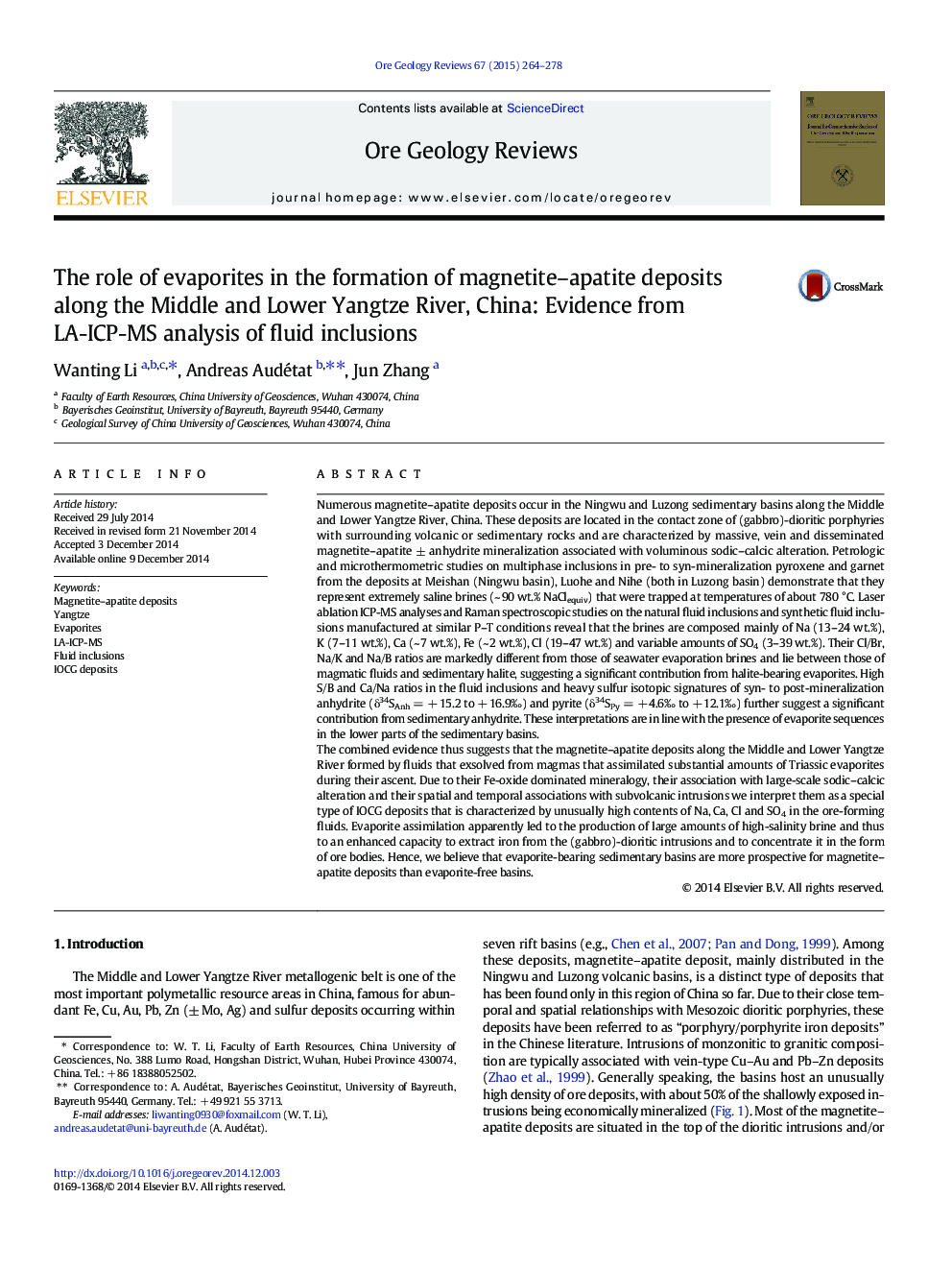| کد مقاله | کد نشریه | سال انتشار | مقاله انگلیسی | نسخه تمام متن |
|---|---|---|---|---|
| 6435893 | 1637237 | 2015 | 15 صفحه PDF | دانلود رایگان |

- Hypersaline brine inclusions in pyroxene and garnet were measured by LA-ICP-MS.
- Halogen ratios suggest major contribution of evaporites to magmatic fluids.
- Major involvement of evaporites confirmed by sulfur isotopic data.
- Evaporites played a key role in the formation of the magnetite-apatite deposits.
Numerous magnetite-apatite deposits occur in the Ningwu and Luzong sedimentary basins along the Middle and Lower Yangtze River, China. These deposits are located in the contact zone of (gabbro)-dioritic porphyries with surrounding volcanic or sedimentary rocks and are characterized by massive, vein and disseminated magnetite-apatite ± anhydrite mineralization associated with voluminous sodic-calcic alteration. Petrologic and microthermometric studies on multiphase inclusions in pre- to syn-mineralization pyroxene and garnet from the deposits at Meishan (Ningwu basin), Luohe and Nihe (both in Luzong basin) demonstrate that they represent extremely saline brines (~ 90 wt.% NaClequiv) that were trapped at temperatures of about 780 °C. Laser ablation ICP-MS analyses and Raman spectroscopic studies on the natural fluid inclusions and synthetic fluid inclusions manufactured at similar P-T conditions reveal that the brines are composed mainly of Na (13-24 wt.%), K (7-11 wt.%), Ca (~ 7 wt.%), Fe (~ 2 wt.%), Cl (19-47 wt.%) and variable amounts of SO4 (3-39 wt.%). Their Cl/Br, Na/K and Na/B ratios are markedly different from those of seawater evaporation brines and lie between those of magmatic fluids and sedimentary halite, suggesting a significant contribution from halite-bearing evaporites. High S/B and Ca/Na ratios in the fluid inclusions and heavy sulfur isotopic signatures of syn- to post-mineralization anhydrite (δ34SAnh = + 15.2 to + 16.9â°) and pyrite (δ34SPy = + 4.6â° to + 12.1â°) further suggest a significant contribution from sedimentary anhydrite. These interpretations are in line with the presence of evaporite sequences in the lower parts of the sedimentary basins.The combined evidence thus suggests that the magnetite-apatite deposits along the Middle and Lower Yangtze River formed by fluids that exsolved from magmas that assimilated substantial amounts of Triassic evaporites during their ascent. Due to their Fe-oxide dominated mineralogy, their association with large-scale sodic-calcic alteration and their spatial and temporal associations with subvolcanic intrusions we interpret them as a special type of IOCG deposits that is characterized by unusually high contents of Na, Ca, Cl and SO4 in the ore-forming fluids. Evaporite assimilation apparently led to the production of large amounts of high-salinity brine and thus to an enhanced capacity to extract iron from the (gabbro)-dioritic intrusions and to concentrate it in the form of ore bodies. Hence, we believe that evaporite-bearing sedimentary basins are more prospective for magnetite-apatite deposits than evaporite-free basins.
Journal: Ore Geology Reviews - Volume 67, June 2015, Pages 264-278